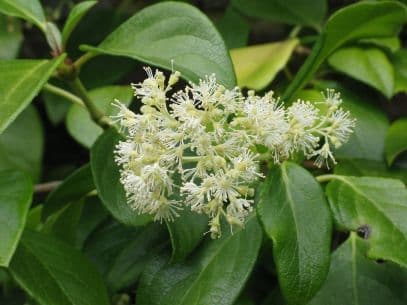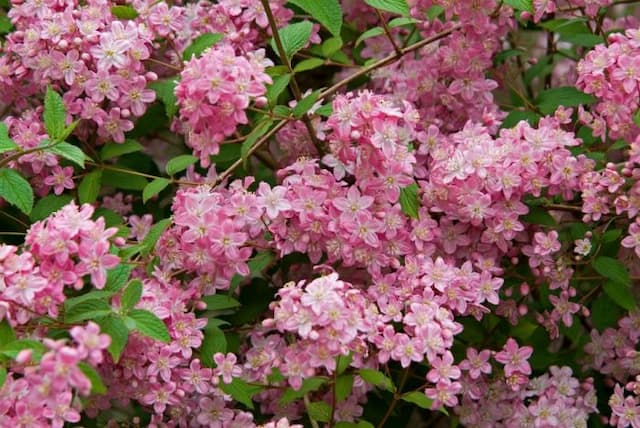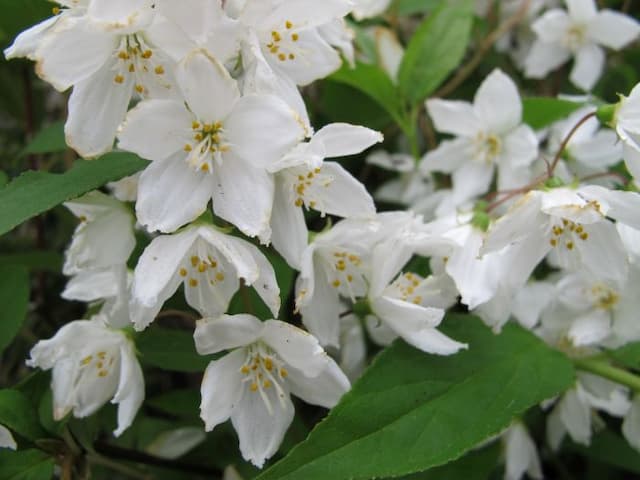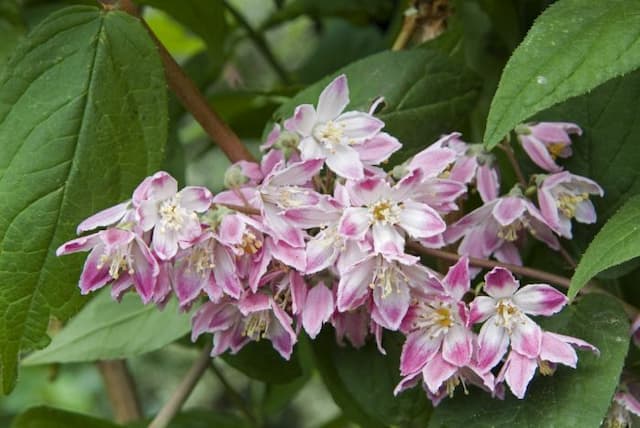Peegee Hydrangea Hydrangea paniculata 'Dolly'

ABOUT
The Hydrangrea paniculata 'Dolly' is a visually striking plant known for its impressive, large cone-shaped flower clusters. These blooms are renowned for their ability to change color over the blooming period, usually starting with a creamy white and gradually transitioning to a rich pink as the season progresses. The flowers are densely packed, creating a lush appearance that is both elegant and eye-catching. The leaves of 'Dolly' are a deep green color and have an ovate shape with pointed ends, providing a beautiful backdrop to the dramatic blooms. This backdrop of foliage not only enhances the visual impact of the flowers but also adds a sense of fullness to the plant's overall appearance. Despite the omission of size-related details, 'Dolly' holds a presence that catches the eye through its vibrant flowering display, making it a popular choice for gardeners and landscapers looking to add a touch of drama to their garden spaces.
About this plant
 Names
NamesFamily
Hydrangeaceae
Synonyms
Panicle Hydrangea, Peegee Hydrangea, Tree Hydrangea
Common names
Hydrangea paniculata 'Dolly'.
 Toxicity
ToxicityTo humans
The common name of Hydrangea paniculata 'Dolly' is Panicled Hydrangea. Panicled Hydrangea is considered to have a low level of toxicity for humans. Ingestion of any part of the plant can lead to gastrointestinal upset, including nausea, vomiting, and diarrhea. The severity of these symptoms can vary based on the amount consumed. Hydrangea plants contain compounds that release cyanide when chewed, but significant poisoning is rare, and serious consequences such as systemic toxicity are not typically seen in humans.
To pets
The common name of Hydrangea paniculata 'Dolly' is Panicled Hydrangea. Panicled Hydrangea is toxic to pets, including dogs and cats. If a pet consumes any part of the plant, they may exhibit symptoms of poisoning which include drooling, vomiting, and diarrhea. Rarely, more severe signs can occur, such as depression or lethargy. The toxic component in hydrangeas is cyanogenic glycoside, which can release cyanide into the body when metabolized. While cases of serious poisoning are uncommon, it is important to keep an eye on pets and contact a veterinarian if ingestion is suspected.
 Characteristics
CharacteristicsLife cycle
Perennials
Foliage type
Deciduous
Color of leaves
Green
Flower color
White
Height
6-8 feet (1.8-2.4 meters)
Spread
6-8 feet (1.8-2.4 meters)
Plant type
Shrub
Hardiness zones
3-8
Native area
China Japan
Benefits
 General Benefits
General Benefits- Aesthetic Appeal: Hydrangea paniculata 'Dolly' provides visual interest with its large, showy flower panicles which change color from pure white to pink as they age.
- Seasonal Interest: It has a long flowering period from mid-summer to fall, offering seasonal beauty in the garden.
- Landscape Versatility: The plant can be used in a variety of landscape designs, including mixed borders, foundation plantings, and as a specimen or accent plant.
- Attracts Pollinators: The flowers attract bees and butterflies, which are essential for pollination and maintaining healthy ecosystems.
- Tolerance of Soil Conditions: This hydrangea is adaptable to various soil types, although it prefers well-draining, fertile soil.
- Cold Hardy: It is relatively cold-hardy, making it suitable for growing in colder climates.
- Pruning Flexibility: The plant blooms on new wood, meaning it can be pruned in late winter or early spring without sacrificing flowers.
- Low Maintenance: Once established, it requires minimal care beyond occasional watering and pruning to maintain its shape and remove spent blooms.
 Medical Properties
Medical PropertiesThis plant is not used for medical purposes.
 Air-purifying Qualities
Air-purifying QualitiesThis plant is not specifically known for air purifying qualities.
 Other Uses
Other Uses- Pressed Flower Crafts: Hydrangea paniculata 'Dolly' blossoms can be pressed and used in crafting, such as making bookmarks, greeting cards, or framed botanical art.
- Photography Background: The lush flowers and foliage of the Hydrangea make it an ideal backdrop for garden photography or portrait sessions.
- Fabric Dyeing: The flowers of the Hydrangea can be used to create natural dyes for fabric, yielding subtle shades of blue, purple, or pink depending on soil pH.
- Dried Flower Arrangements: Their blooms can be dried and used in long-lasting, decorative floral arrangements without requiring water.
- Wedding Decor: Fresh or dried Hydrangea flowers are often used in wedding bouquets, centerpieces, and venue decorations due to their voluminous and colorful blooms.
- Teaching Tool: The plant's pH-dependent flower color change can be used as a botanical teaching example of soil chemistry effects on plant physiology.
- Edible Blooms: While not commonly consumed, Hydrangea blooms can be crystallized with sugar and used as edible decorations for desserts, although some people may be sensitive to them.
- Garden Theming: Use the Hydrangea to create themed garden areas, like a "cool colors" garden featuring blues and purples, or a "fairy" garden for whimsical landscapes.
- Ice Decorations: Freeze small Hydrangea flowers into ice cubes for an elegant touch in summer beverages, ensuring that no toxic pesticides have been used on the flowers.
- Floral Water: Soak petals in water to create a delicately scented floral water for rinsing linens or as a room freshener, taking care to avoid using chemically treated blooms.
Interesting Facts
 Feng Shui
Feng ShuiThe hydrangea is not used in Feng Shui practice.
 Zodiac Sign Compitability
Zodiac Sign CompitabilityThe hydrangea is not used in astrology practice.
 Plant Symbolism
Plant Symbolism- Gratitude: Hydrangeas can represent gratitude for being understood, making it a great gift to express thanks.
- Heartfelt Emotions: Their lush blooms can also convey deeper, heartfelt emotions to the recipient.
- Apology: Sometimes, hydrangeas mean an apology or a desire for forgiveness, as they can indicate remorse.
- Boastfulness: In some cultures, hydrangeas are linked to boastfulness or vanity due to the showy nature of their large flower heads.
- Frigidity: The plant has historical associations with frigidity or disinterest, particularly in Victorian symbolism.
- Abundance: The lavish number of flowers and their round shape can also symbolize abundance and prosperity.
 Water
WaterThe PeeGee Hydrangea should be watered deeply and thoroughly, which can mean infusing the soil with about 1-2 gallons of water for established plants, ensuring that the moisture penetrates deeply. During the growing season, watering should be done once or twice a week, depending on weather conditions – more frequently during hot, dry spells, and less during cool, rainy periods. It's essential to avoid waterlogging, therefore always check the soil moisture before watering; it should be moist but not saturated. Overhead watering should be avoided to reduce risk of leaf diseases; instead, target the base of the plant.
 Light
LightThe PeeGee Hydrangea thrives best in full sun to partial shade. Ideally, it should get at least 4 hours of direct sunlight each day, but it can also perform well in dappled or afternoon shade. The best spot for these hydrangeas would be one where they receive morning sunlight and some afternoon protection, particularly in hotter climates.
 Temperature
TemperatureThe PeeGee Hydrangea is hardy and can tolerate a range of temperatures, but it performs best when the temperature is between 65 and 75 degrees Fahrenheit. It can survive in temperatures as low as 0 degrees and as high as 80 degrees Fahrenheit, but extreme temperatures outside of this range can cause stress or damage to the plant.
 Pruning
PruningPruning the PeeGee Hydrangea is important for maintaining its shape and encouraging more prolific blooms. Prune in late winter or early spring before new growth begins, cutting back the previous year's growth to a pair of healthy buds to encourage branching. It is typically done annually but may be adjusted based on the plant's performance and desired size. The best time for major pruning is when the plant is dormant.
 Cleaning
CleaningAs needed
 Soil
SoilThe ideal soil mix for the panicled hydrangea, commonly known as 'Dolly', is well-draining, rich in organic matter with a pH range of 5.5 to 6.5. A mix of garden soil, compost, peat moss, and perlite or vermiculite works well to maintain the necessary balance of moisture and aeration.
 Repotting
RepottingPanicled hydrangeas like 'Dolly' typically don't need frequent repotting as they are mostly grown directly in the ground. If grown in containers, they should be repotted when they become root-bound or every 2-3 years to replenish the soil and accommodate root growth.
 Humidity & Misting
Humidity & MistingPanicled hydrangeas such as 'Dolly' prefer average humidity levels. They can adapt to different humidity conditions but thrive best when they are not subjected to extremely dry environments, so maintaining a moderate humidity level is advisable.
 Suitable locations
Suitable locationsIndoor
Place in bright, indirect light and keep soil moderately moist.
Outdoor
Choose a spot with morning sun, afternoon shade, and sheltered from strong winds.
Hardiness zone
3-8 USDA
 Life cycle
Life cycleHydrangea paniculata 'Dolly', commonly known as Dolly Panicle Hydrangea, begins its life cycle from a seed or more commonly from cuttings, which once rooted, will grow into a young plant. After planting, it enters a vegetative stage where it develops a robust root system and foliage. During spring and summer, it enters the flowering stage, with large, cone-shaped flower clusters that can vary from white to pink as they mature. After blooming, the flowers fade, and if pollinated, they may produce seeds that can be dispersed for propagation. In autumn, the plant prepares for dormancy as leaves change color and fall off, conserving energy in its root system throughout the winter. With the return of warmer temperatures in spring, the hydrangea exits dormancy, initiating a new growth cycle with fresh shoots and leaves, leading back to the flowering stage.
 Propogation
PropogationPropogation time
Spring-Early Summer
The Hydrangea paniculata 'Dolly', commonly known as the panicled hydrangea, is most effectively propagated through softwood cuttings. This approach is best undertaken in the late spring or early summer when the plant's new growth is still tender and green. To propagate, select healthy, non-flowering shoots and cut a 4 to 6 inch (approximately 10 to 15 centimeters) section just below a leaf node. The cutting should have at least three sets of leaves. Remove the leaves from the lower half of the cutting to expose the nodes, as this is where the roots will emerge. Dip the base of the cutting in rooting hormone to encourage root development and plant it in a mix of peat and perlite to provide adequate drainage and support. The cutting should be kept under conditions of high humidity, and it is crucial to maintain consistent moisture but avoid waterlogged soil. With proper care, the cutting will develop roots and can be transplanted into the garden or a larger pot.






![Rose deutzia [Yuki Cherry Blossom]](/_next/image?url=https%3A%2F%2Fplants-admin.emdemapps.com%2Fimages%2Fplants%2F%2Fimages%2F604b6510a383a.png&w=640&q=75)
![Hydrangea [Hot Chocolate]](/_next/image?url=https%3A%2F%2Fplants-admin.emdemapps.com%2Fimages%2Fplants%2F%2Fimages%2F604b5a066e3bd.png&w=640&q=75)
![Hydrangea [Blackberry Pie]](/_next/image?url=https%3A%2F%2Fplants-admin.emdemapps.com%2Fimages%2Fplants%2F%2Fimages%2F604b56e2abc1d.png&w=640&q=75)
